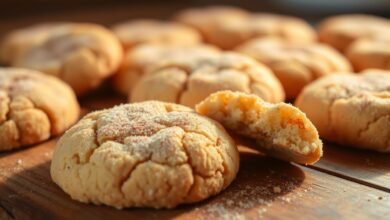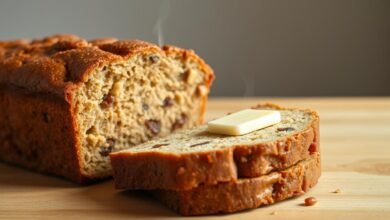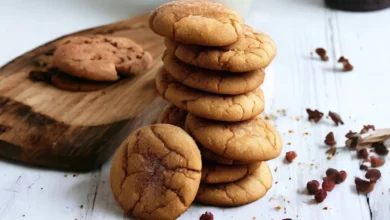
Sugar Free Cheesecake Recipe — Make a classic low-carb cheesecake that feels indulgent without the usual carbs. In this short guide you’ll get a clear, tested path from crust to slice. The method balances creaminess, structure, and a bright tang so each bite tastes like the real thing.
You’ll learn when to bake in the oven and when to skip it for a no-bake version set with whipped cream. The recipe focuses on full-fat cream cheese, a powdered sweetener in the filling, and fresh lemon and vanilla to lift flavor.
Tips on timing, using a water bath for ultra-creamy texture, and choosing a crust—almond or coconut flour—help you avoid cracks and soggy edges. Follow simple steps and chill the pan long enough so the center firms without drying out.
Key Takeaways
- One clear Sugar Free Cheesecake recipe delivers rich texture with low carb ingredients.
- Use a water bath for creamy baked results; chill at least 4 hours or overnight.
- Choose powdered sweetener to avoid grittiness and blend on low to limit air bubbles.
- No-bake option uses whipped cream and sets in 6–8 hours for a lighter finish.
- Crusts can be almond or coconut flour; a crustless option works well for easy removal.
- Store covered up to four days or freeze slices for longer keeping.
Why You’ll Love This Sugar-Free Cheesecake Right Now
You get dessert-level satisfaction with a low carb cheesecake that keeps the classic, creamy bite. A water bath protects the pan from direct heat, so the center stays custardy and resists cracks.
Room-temperature ingredients blend smoothly, which cuts mixing time and helps the filling set with a uniform texture. Using powdered sweetener prevents grittiness so each forkful tastes silky.
- Make ahead: bake today, chill overnight, and serve tomorrow — great for saving time.
- Top with seasonal fruit or berries for fresh brightness without added refined sweeteners.
- Choose nut-based crusts to keep carbs low and flavors rich.
Whether you bake with a water bath or go no-bake, you’ll get consistent results and a professional finish. The center should be slightly jiggly when it comes out; it will firm as it cools and chills.
Ingredients You’ll Need for the Creamiest Result
Choose quality, room-temperature dairy and finely powdered sweeteners to get a silky filling with minimal mixing time. Gather everything ahead so you can blend at low to medium speed and avoid trapped air.
Cream cheese, sour cream, and vanilla extract: room temperature matters
Start with full-fat cream cheese for body and richness. Bring it to room temperature so it mixes smooth and lump-free.
Add sour cream for moisture and tang. It helps the filling set with a creamy texture after chilling.
Stir in vanilla extract and a pinch of salt to round flavors and balance sweetness.
Sweeteners that actually dissolve
Use powdered sweetener such as powdered erythritol, monk fruit blends with allulose, or pure allulose. These dissolve fully and keep the batter silky.
Avoid liquid sweeteners in the filling and crust. Liquids can make the batter runny and change baking behavior.
Lemon juice and a pinch of salt for balance
Add a little lemon juice to brighten the profile without adding sugar. A pinch of salt lifts the vanilla and deepens overall flavor.
Quick comparison
| Ingredient | Why it matters | Tip |
|---|---|---|
| Cream cheese | Provides richness and structure | Use softened, room temperature blocks |
| Sour cream | Adds moisture and tang | Full-fat for best texture |
| Powdered sweetener | Prevents grittiness, dissolves cleanly | Choose erythritol or monk/allulose blend |
| Lemon juice & salt | Brightens flavor and balances sweetness | Use a squeeze of lemon and a small pinch |
Essential Tools and Prep For Sugar Free Cheesecake Recipe
Gather the right tools before you start so assembly and baking stay calm and efficient. A clean workspace and the correct gear make a big difference in final texture and presentation.
Choose a 9-inch springform pan for baked versions and a 7-inch springform or loose-bottom tin for no-bake builds. Line the base with parchment paper so the crust won’t stick and slices release cleanly.
If you want an ultra-creamy finish, opt for a water bath. Wrap the springform pan in 2–3 layers of foil, set it inside a larger roasting pan, and pour hot water until it reaches about 2 inches up the sides.
Preheat the oven to 350°F when the crust needs baking; bake a lined crust 10–12 minutes and cool fully before adding filling. Manage oven temperature to avoid overcooking the center.
- Keep ingredients at room temperature to cut mixing time and reduce trapped air.
- Arrange tools—mixer, spatula, foil, roasting pan, and parchment—so you move quickly during prep.
- Adjust pan size if needed and change bake or chill time to keep the center set without dry edges.
Sugar Free Cheesecake: Step-by-Step Baked Method
This baked method walks you through pan prep, gentle mixing, and proper bake time so your dessert sets with a smooth, glossy interior.
Prep the springform and preheat the oven to 350°F. Line a 9-inch springform pan with parchment and press the crust evenly so it bakes without thin spots.
Mix at low to medium speed. Beat softened cream cheese with powdered sweetener on low, then add eggs one at a time. Stir in lemon and vanilla. Keep the mixer slow to limit air bubbles.
- Pour filling over the cooled crust and smooth the top; tap gently to release trapped bubbles.
- Choose a water bath by wrapping the springform in foil and placing it in a larger pan with hot water for a creamier result.
- Bake 40–55 minutes until the center is almost set but still jiggly; this prevents overbaking and dry edges.
Run a knife around the edge if needed, then cool to room temperature in the pan. Chill at least 4 hours, preferably overnight, so the center becomes fully set.
Do not remove cheesecake from the pan before it is fully set. Release the springform carefully after chilling for clean sides and a professional finish.
No-Bake Option for Busy Days
If you need dessert without the oven, this no-bake recipe gives you creamy results in minimal time. The filling sets with whipped heavy cream instead of eggs and chills until firm.
Whipped-cream set method
Start with room-temperature cream cheese and beat it with powdered sweetener, lemon juice, vanilla, and a pinch of salt until silky. Whip heavy cream to soft, thick peaks and fold it in gently to preserve air and volume.
- Press an almond or coconut flour crust (or go crustless) into the pan.
- Spoon the folded filling over the crust and level the surface for even chilling.
- Chill 6–8 hours or overnight until the texture is firm enough to slice cleanly.
- Optionally, pop the pan in the freezer for 30 minutes before slicing to sharpen edges without freezing solid.
Powdered sweetener is essential for a smooth finish; it prevents graininess and weeping. This no-bake route saves you oven time and keeps the kitchen cool while delivering a light, creamy dessert you can make ahead.
Crust Choices: Almond Flour, Coconut Flour, or Crustless

Pick the base that supports the texture and flavor you want. Your crust influences bite, release, and how well toppings like fresh fruit pair with each slice.
Buttery almond flour crust and nut variations
Make a classic low carb crust with almond flour, melted butter, and a granular or powdered sweetener. Press it firmly for a shortbread-like base.
Bake 10–12 minutes for structure in the baked version, then cool completely before adding filling. Swap almonds with ground pecans or walnuts for a deeper, toasty note.
Coconut flour adjustments and dairy-free swaps
Coconut flour absorbs more liquid, so reduce the amount and add extra butter or coconut oil to bind the crumbs. For dairy-free options, use coconut oil or ghee instead of butter.
Go crustless: how to line and release cleanly
For a crustless approach, line the springform pan with parchment paper so the dessert releases without sticking. Press any thin crust evenly to the edges to avoid weak spots.
Tip: Match the base flavor to toppings—nutty crusts pair well with chocolate, caramel, or bright fruit for balanced bites.
Sweetener Guide: Taste, Texture, and Conversions
How a sweetener dissolves affects whether your filling is silky or grainy. Your choice changes flavor, browning, and how the custard sets.
Powdered sweeteners belong in the filling. Erythritol does not melt like sugar and can leave a cooling sensation unless it’s powdered. Powdered monk fruit–allulose blends (Besti-style blends work well) give cleaner sweetness with less cooling.
Powdered vs. granulated, blends, and what to avoid
Use powdered sweetener for the filling to avoid grit. Granulated erythritol or xylitol can be used in crusts, but avoid liquid sweeteners there—they make crusts runny and change bake dynamics.
Allulose, erythritol, monk fruit, and stevia notes
Allulose browns and tastes closest to sugar, while erythritol cools the tongue. Monk fruit is often blended with erythritol, which alters sweetness and bulk.
| Sweetener | Best use | Note |
|---|---|---|
| Allulose | Filling & browning | Closes sugar gap; browns like sugar |
| Erythritol (powdered) | Filling when powdered | Can cool; powder to dissolve |
| Monk fruit blends | Filling and crust | Clean sweetness; follow brand charts |
- Follow conversion charts or powder granulated sweeteners in a blender for solubility.
- Use stevia only as a booster, not bulk—your recipe needs volume for proper set.
Pro Tips to Nail the Texture Every Time
Nailing a silky filling starts with small habits that control air, heat, and how you finish the pan. These simple moves help your cheesecake set evenly and slice cleanly.
Use room temperature ingredients and keep mixer speed moderate
Bring cream cheese, eggs, and sour cream to room temperature so the mixer runs smoothly. A cold block forces long beating and creates lumps.
Mix at low to medium speed to limit air. Too much air makes the batter rise and then collapse, harming texture and adding cracks.
Prevent cracks: water bath basics, gentle cooling, and pan release
Wrap the springform and use a water bath to regulate oven temperature. This reduces stress on the custard and keeps edges moist.
After baking, cool slowly with the oven door ajar or on the counter, then run a knife around the pan edge before chilling. This prevents tearing as the center contracts.
Fix common issues: gritty texture, runny center, dry edges
- Prevent grit by using powdered sweetener in the filling and mixing until silky.
- If the center is runny, add short increments of bake time until the wobble is a gentle jiggle—don’t overshoot.
- Avoid dry edges by not overbaking and by keeping the pan in a water bath when possible. Chill long enough for clean slices.
Tap the pan before it goes into the oven to release trapped bubbles. That small step preserves a uniform custard from edge to center and saves you time correcting problems later.
Toppings and Serving Ideas

Bright, balanced toppings turn each slice into a finished dessert worth serving. Choose garnishes that add color and contrast without making the surface soggy.
Fresh fruit, sauces, and drizzles
Top the chilled cake with fresh berries or a fruit-forward sauce for a lively finish. For a seedless raspberry sauce, simmer raspberries with powdered sweetener, or puree and strain fresh berries for a smooth pour.
If you want decadence, drizzle a bit of melted chocolate or a ribbon of sugar-free caramel. These pair especially well with nutty crusts and deepen the overall flavor.
Whipped cream and plating tips
Add whipped cream just before serving so peaks stay pillowy. Use a warm, sharp knife to cut clean slices after a full chill. Wipe the blade between cuts for crisp edges.
- Top after unmolding to prevent pooled moisture.
- Quick-chill in the freezer 30 minutes to sharpen edges before slicing.
- Store covered in the fridge for 3–5 days.
Storage, Freezing, and Make-Ahead Timeline
Plan storage and thawing up front so your dessert holds shape and flavor when guests arrive. A simple timeline keeps the texture steady and helps you slice cleanly from the pan the next day.
Fridge: Store the chilled cake covered for 3–5 days to keep moisture and cream texture. If you assemble a day early, the filling firms and you get perfect slices after an overnight chill.
Freezer: Wrap whole cakes or individual slices tightly without toppings. Freeze for best texture up to 1 month; up to 3 months is acceptable. Label date and flavor so you can rotate supplies easily.
Thawing and serving
- Thaw whole in the fridge overnight. For single slices, allow 1–4 hours in the fridge or 2–4 hours at room temperature depending on size.
- Use a hot, dry knife to cut smooth slices after thawing; wipe the blade between cuts for clean edges.
- Keep the dessert cold until serving since cream-based fillings soften quickly at room temperature.
- Top after thawing to preserve whipped cream peaks and fresh fruit color.
| Storage | Duration | Tip |
|---|---|---|
| Refrigerator | 3–5 days | Cover pan tightly; chill overnight before slicing |
| Freezer (whole) | 1 month preferred, up to 3 months | Wrap in plastic and foil; remove toppings first |
| Freezer (slices) | 1–3 months | Wrap individually; thaw slices in fridge 1–4 hours |
| Serving | Immediate after thaw | Use hot knife; top after thawing |
Quick reminder: If you follow this timeline, your low carb recipe will hold texture and flavor. Track dates, keep it cold, and slice confidently when it’s time to serve.
Nutrition Notes and Low Carb Swaps
Choose swaps that reduce carbs without sacrificing flavor. You can keep each slice satisfying by adjusting the base, filling, and toppings. Small swaps help you stay within goals while enjoying a rich dessert.
Carb-conscious choices for crust, filling, and toppings
A typical no-bake slice without topping is about 2.8g net carbs. Add a modest portion of berries and extra cream and it rises to roughly 3.8g. Use that range to plan portions and macros.
- Keep carbs low by using almond or coconut flour in the crust and powdered sweeteners in the filling.
- Choose fresh berries sparingly as a low-impact fruit option for color and acidity.
- Swap to dairy-free fats like coconut oil or ghee if avoiding butter; net carb impact stays minimal.
- Use vanilla and lemon to boost flavor without changing carbs significantly.
- Always check labels on sweeteners and chocolate to avoid hidden sugars that raise total carbs.
| Component | Low-carb option | Net carb impact |
|---|---|---|
| Crust | Almond flour or coconut flour | Low; 1–3g per slice depending on thickness |
| Filling | Powdered erythritol or allulose blends | Minimal; sweeteners add sweet taste, not net carbs |
| Toppings | Fresh berries, light cream | +1.0g to +1.5g per serving if used sparingly |
| Swaps | Dairy-free fats, crustless option | Maintains low carb profile when sugar substitutes used |
Tip: Slice thin and serve chilled to keep portions in check. These simple swaps let you adapt recipes and enjoy a sugar-free cheesecake that fits a low carb lifestyle.
Sugar Free Cheesecake Recipe : Conclusion
A short rest at room temperature followed by a full chill gives you reliable slices with clean edges. Allowing time to cool and set is the final, essential step that turns good into great.
You now have a dependable, sugar free recipe you can bake with a water bath or set as a no-bake. Keep the right ingredients and tools—room-temperature dairy, powdered sweetener, a springform pan, and parchment—to streamline the process.
Recognize doneness by a gentle jiggle in the center. Tailor the crust from almond or coconut flour or go crustless, and finish each slice with fresh berries, whipped cream, or a drizzle on top.
Store, freeze, and thaw using the tips above so every slice tastes bakery-quality. With these steps you can plate, slice, and serve confidently and enjoy this low-carb cheesecake any time.


